 As privacy fears around search engines and the Justice Department continue to rise, the issue of personal privacy is being thrust, once again, into the public spotlight. The conversation generally goes like this: “All the search engines are collecting information about us. There isn’t enough protection for our personal information. Companies must do more.” Suggestions of what ‘more’ is are numerous, while solutions are few and far between. Social engineering solutions that do exist fail to include effective ways of securing online activities. Technical services that allow you to completely protect your identity are geek oriented and lacking the polish of Google or Yahoo!.
As privacy fears around search engines and the Justice Department continue to rise, the issue of personal privacy is being thrust, once again, into the public spotlight. The conversation generally goes like this: “All the search engines are collecting information about us. There isn’t enough protection for our personal information. Companies must do more.” Suggestions of what ‘more’ is are numerous, while solutions are few and far between. Social engineering solutions that do exist fail to include effective ways of securing online activities. Technical services that allow you to completely protect your identity are geek oriented and lacking the polish of Google or Yahoo!.
Why is this privacy thing an issue, anyway? People feel strongly about their privacy and protecting their identities, but are lazy when it comes time to protect themselves. Should this be taken for a disinterested acknowledgement that we don’t care about our personal data? Short answer: no. If we look at what’s happening on the other side of things—the data that people put out there willingly, on sites like MySpace, and blogs, and flickr, I think the answer is obvious. Personal data is constantly being added to the virtual space because it represents who we are. 
Identity production is a large part of online culture, and has been from the very first days of the Well. Our personal information is important to us, but the apathy arises from the fact that we have no substantitive rights when it comes to controlling it [1].
There are a few outlets where we can wrangle our information into a presentation of ourselves, but usually our data accumulates in drifts, in the dusty corners of databases. When search engines crawl through those databases the information unintentionally coalesces into representations of us. In the real world the ability to keep distance between social spheres is fundamental to the ability to controlling your identity; there is no distance in cyberspace. Your info is no longer dispersed among the different spheres of shopping sites, email, blogs, comments, or bulletin boards, reviews. Search engines collapse that distance completely and your distributed identity becomes an aggregate one; one we might not recognize if it came up to us on the street.
There are two ways to react: 1) with alarm: attempt to keep things wrapped in layers of protection, possibly remove it entirely, and call for greater control and protection of our personal information. Or 2) with grace: acknowledge our multiple identities, and create a meta-identity, while still making a call for better control of our personal data. The first reaction is about identity control and privacy and relies on technical solutions or non-participation. Products like sxip and schemes like openID allow you to confirm that you are who you say you, and groups like EPIC, and federal legislation (HIPAA, FERPA, definitely not the PATRIOT Act) help protect your information. But eventually this route is not productive—it doesn’t embrace the reality of living with and within a networked environment. The second reaction is about “identity production” [2], and that’s where sites like MySpace and blogs reign. There’s also a new service, ClaimID, that will help you create a meta-identity with a slick, web 2.0 workflow (full disclosure: the founder is a former colleague).
![]() ClaimID is interesting in several respects. It let’s you actively manage your identity by aggregating information about yourself through searches, then tagging each item with several levels of aboutness. So you could say that your website is about you, and by you, whereas an article that mentions your name in conjunction with a project is not about you, or by you. Still, it’s part of your online persona. An interview: about you, not by you. A short history of New York: by you, not about you. ClaimID allows you to have these different permutations of relationship that help define the substance within and the ownership of each item. Everything can be tagged with keywords to link items. What you end up with is a web of yourself, annotated and organized so that people can get to know you in the way you want to be known.
ClaimID is interesting in several respects. It let’s you actively manage your identity by aggregating information about yourself through searches, then tagging each item with several levels of aboutness. So you could say that your website is about you, and by you, whereas an article that mentions your name in conjunction with a project is not about you, or by you. Still, it’s part of your online persona. An interview: about you, not by you. A short history of New York: by you, not about you. ClaimID allows you to have these different permutations of relationship that help define the substance within and the ownership of each item. Everything can be tagged with keywords to link items. What you end up with is a web of yourself, annotated and organized so that people can get to know you in the way you want to be known.
This helps combat the unintentional aggregation of information that happens within search engines. But we also need to be aware that intentional aggregation does not mean it is trustworthy information, just as unintentional does not always mean “true to life”. We have a sense that when people manage their identities that they are repositioning the real in favor of a something more appropriate for the audience. We therefore put greater stock in what we find that seems unintentional—yet this information is not logically more reliable. We have to be critical of both the presented, vetted information and the aggregated, unintentional information. We still need privacy rights, and tools to help protect our identities from theft, spoofing, or intrusion, but in the meantime we have the opportunity to actively negotiate the bits and pieces of our identities on the network.
Category Archives: Mediated Existence
truth through the layers
 Pedro Meyer’s I Photograph to Remember is a work originally designed for CD ROM, that became available on the Internet 10 years later. I find it not only beautiful within the medium limitations, as Pedro says on his 2001 comment, but actually perfectly suited for both, the original CD ROM, and its current home on the internet . It is a work of love, and as such it has a purity that transcends all media.
Pedro Meyer’s I Photograph to Remember is a work originally designed for CD ROM, that became available on the Internet 10 years later. I find it not only beautiful within the medium limitations, as Pedro says on his 2001 comment, but actually perfectly suited for both, the original CD ROM, and its current home on the internet . It is a work of love, and as such it has a purity that transcends all media.
The photographs and their subject(s) have such degree of intimacy that forces the viewer to look inside and avoid all morbidity or voyeurism. The images are accompanied by Pedro Meyer’s voice. His narration, plain and to the point, is as photographic as the pictures are eloquent. The line between text and image is blurred in the most perfect b&w sense. The work evokes feelings of unconditional love, of hands held at moments of both weakness and strength, of happiness and sadness, of true friendship, which is the basis of true love. The whole experience becomes introspection, on the screen and in the mind of the viewer.
IPTR was originally a Voyager CD ROM, and it was the first ever produced with continuous sound and images, a possibility that completes, and complements, image as narration and vice-versa. The other day Bob Stein showed me IPTR on his iPod and expressed how perfectly it works on this handheld device. And, it does. IPTR is still a perfect object, and as those old photographs exist thanks to the magic of chemicals and light, this exists thanks to that “old” CD ROM technology, and will continue to exist inhabiting whatever medium necessary to preserve it.
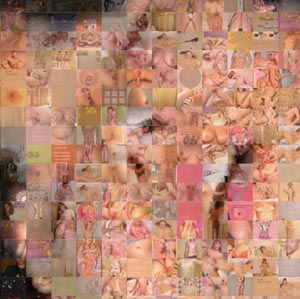 I’ve recently viewed Joan de Fontcuberta’s shows in two galleries in Manhattan; Zabriskie and Aperture,) and the connections between IPTR and these works became obsessive to me. Fontcuberta, also a photographer, has chosen the Internet, and computer technology, as the media for both projects. In “Googlegrams,” he uses the Google image search engine to randomly select images from the Internet by controlling the search engine criteria with only the input of specific key words.
I’ve recently viewed Joan de Fontcuberta’s shows in two galleries in Manhattan; Zabriskie and Aperture,) and the connections between IPTR and these works became obsessive to me. Fontcuberta, also a photographer, has chosen the Internet, and computer technology, as the media for both projects. In “Googlegrams,” he uses the Google image search engine to randomly select images from the Internet by controlling the search engine criteria with only the input of specific key words.
These Google-selected images are then electronically assembled into a larger image, usually a photo, of Fontcuberta’s choosing (for example, the image of a homeless man sleeping on the sidewalk reassembled from images of the 24 richest people in the world, Lynddie England reassembled from images of the Abu Ghraib’s abuse, or a porno picture reassembled from porno sites.). The end result is an interesting metaphor for the Internet and the relationship between electronic mass media and the creation of our collective consciousness.
For Fontcuberta, the Internet is “the supreme expression of a culture which takes it for granted that recording, classifying, interpreting, archiving and narrating in images is something inherent in a whole range of human actions, from the most private and personal to the most overt and public.” All is mediated by the myriad representations on the global information space. As Zabriskie’s Press Release says, “the thousands of images that comprise the Googlegrams, in their diminutive role as tiles in a mosaic, become a visual representation of the anonymous discourse of the internet.”
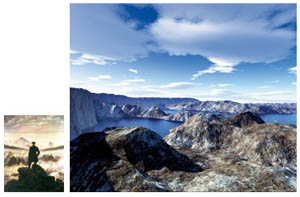 Aperture is showing Fontcuberta’s “Landscapes Without Memory” where the artist uses computer software that renders three-dimensional images of landscapes based on information scanned from two-dimensional sources (usually satellite surveys or cartographic data.) In “Landscapes of Landscapes” Fontcuberta feeds the software fragments of pictures by Turner, Cézanne, Dalí, Stieglitz, and others, forcing the program to interpret this landscapes as “real.”
Aperture is showing Fontcuberta’s “Landscapes Without Memory” where the artist uses computer software that renders three-dimensional images of landscapes based on information scanned from two-dimensional sources (usually satellite surveys or cartographic data.) In “Landscapes of Landscapes” Fontcuberta feeds the software fragments of pictures by Turner, Cézanne, Dalí, Stieglitz, and others, forcing the program to interpret this landscapes as “real.”
These painted and photographic landscapes are transformed into three-dimensional mountains, rivers, valleys, and clouds. The result is new, completely artificial realities produced by the software’s interpretation of realities that have been already interpreted by the painters. In the “Bodyscapes” series, Fontcuberta uses the same software to reinterpret photographs of fragments of his own body, resulting in virtual landscapes of a new world. By fooling the computer Fontcuberta challenges the limits between art, science and illusion.
Both Pedro Meyer and Joan de Fontcuberta’s use of photography, technology and the Internet, present us with mediated worlds that move us to rethink the vocabulary of art and representation which are constantly enriched by the means by which they are delivered.
letters from second life

Last week, Bob mentioned that Larry Lessig, law profressor and intellectual property scholar, was being interviewed in Second Life, the virtual world created by Linden Lab. Having heard a lot of Second Life before, I was pleased to have a reason and opportunity to create an account and explore it. Basically I quickly learned that it’s Metaverse, as described in Neil Stephenson’s Snowcrash, in operation today, and I’m now a part of it too.
I already covered the actual interview. Here are a few observations from my introduction to SL.
Second Life is a humbling place, especially for beginners. Everything ,even the simplest things, must be relearned. It took me 5 minutes to learn how to sit down, another 5 minutes to read something, and on and on. Traveling to the site of Lessig event was an even more daunting task. I was given the location of this event, a name and coordinates, without any idea of what to do with them. Second Life is a vast space, and it wasn’t clear to me how to get from one point to another. I had no idea how to travel in SL, and had to ask around someone.
I presume it is evident that I’m very new to SL, by my constant trampling over people and inanimate objects. So, I continue walking into trees and rocks until I come across someone whose title contains “Mentor,” and figure that this is a good person to ask for help. Not knowing how to strike up a private conversation, I start talking out loud, not even sure if anyone is even going to pay attention.
(I will come to learn that you travel from place to place via teleportation.)
“Hi.”
“Hi Harold.”
I am relieved to discover that people are basically nice in SL, maybe even nicer than in New York. This fellow avatar is happy to chat and answer questions. Second List has a feature called “Friends” which operates like Buddies in Instant Messaging. However, I’m not sure what the social protocol for making friends is, so I make no assumptions. As I was typing “can we be friends?” I sigh with the realization that I am, in fact, back in fourth grade.
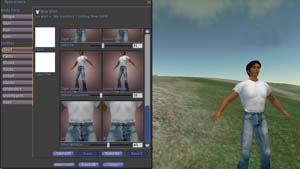 People around me have much more sophisticated outfits than I do. So, I try out the free clothing features. I darken my pants to a deep blue and my shoes black. Then, my default shirt gets turned into a loose white t-shirt. Somehow I end up a bit like a GAP model crossed with Max Headroom. After making my first “friend,” another complete stranger comes up to me and just starts giving me clothes. Apparently, my clothes still need a little work. I try on the cowboy boots and faded jeans. Happy that I’ve moved beyond the standard issue clothes, I thank my benefactor and begin to make my way to the event.
People around me have much more sophisticated outfits than I do. So, I try out the free clothing features. I darken my pants to a deep blue and my shoes black. Then, my default shirt gets turned into a loose white t-shirt. Somehow I end up a bit like a GAP model crossed with Max Headroom. After making my first “friend,” another complete stranger comes up to me and just starts giving me clothes. Apparently, my clothes still need a little work. I try on the cowboy boots and faded jeans. Happy that I’ve moved beyond the standard issue clothes, I thank my benefactor and begin to make my way to the event.
The builders of Second Life force people to rely on other people within the virtual world. However, assistance in the real world certainly helps too. Entering Second Life, the feeling of displacement is quite clear, as if I arrived to a new city in the real world with a single address, where I don’t know anyone or how to navigate the city. The virtual world often mimics the real world, but my surprise each time I learn this fact is still ongoing. It definitely helps to know people, both in where to go that’s interesting and how to do things.
After teleporting to the event, I found myself around people who had common interests, which was great and similar to attending a lecture in the real world. At different times, I struck up a conversation with an avatar who is a publisher on the West Coast and then talked to an academic who runs a media center. In both cases, I was talking to the person literally “next” to me.
When I first heard about the interview, I learned at there was limited spacing. Which seemed strange to me, as it was taking place in a viritual space. When I arrived at the event place, I saw the ampitheater with video screens, that would show a live web stream of Lessig. The limited seating made more sense, seeing the seat of the theater. I also believe that the SL servers also have a finite capacity for the number of people to be located within a small area, because movement was jerky around concentrated groups of people. I guess I’ll have to wait for the Second Life Woodstock.
The space was crowded with people walking around, chatting, and getting up their free digital copy of Lessig’s book, “Free Culture.” (I’ve included a picture of me reading Free Culture in Second Life. You can actually read the text.) 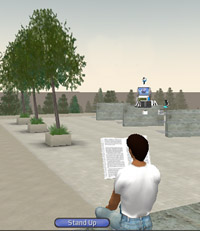 The interview is about to begin, as an avatar with large red wings walks by me. I say out loud, “I know she was going to sit in front of me.” Adding, “Just kidding,” in case I might be offending someone, who knows who this person could be. Fortunately, she found a seat outside my sight line without incident, and the introductory remarks began.
The interview is about to begin, as an avatar with large red wings walks by me. I say out loud, “I know she was going to sit in front of me.” Adding, “Just kidding,” in case I might be offending someone, who knows who this person could be. Fortunately, she found a seat outside my sight line without incident, and the introductory remarks began.
There was a strange duality where I had to both learn what was being said, but also how to navigate the environment of a lecture as well. The interview proceeds within the social norms of a lecture. People are mostly quiet, clap and for the moderator runs the question and answer session. Afterwards, I line up to get Lessig to “sign” my virtual book at the virtual booksigning, as in my virtual public event. I finally stumble my way through the line, all the while asking many question on what I’m supposed to do. With my signed book in hand, I look at the sky, which is quite dark. I log out and return to the real world.
ESBNs and more thoughts on the end of cyberspace
Anyone who’s ever seen a book has seen ISBNs, or International Standard Book Numbers — that string of ten digits, right above the bar code, that uniquely identifies a given title. Now come ESBNs, or Electronic Standard Book Numbers, which you’d expect would be just like ISBNs, only for electronic books. And you’d be right, but only partly.  ESBNs, which just came into existence this year, uniquely identify not only an electronic title, but each individual copy, stream, or download of that title — little tracking devices that publishers can embed in their content. And not just books, but music, video or any other discrete media form — ESBNs are media-agnostic.
ESBNs, which just came into existence this year, uniquely identify not only an electronic title, but each individual copy, stream, or download of that title — little tracking devices that publishers can embed in their content. And not just books, but music, video or any other discrete media form — ESBNs are media-agnostic.
“It’s all part of the attempt to impose the restrictions of the physical on the digital, enforcing scarcity where there is none,” David Weinberger rightly observes. On the net, it’s not so much a matter of who has the book, but who is reading the book — who is at the book. It’s not a copy, it’s more like a place. But cyberspace blurs that distinction. As Alex Pang explains, cyberspace is still a place to which we must travel. Going there has become much easier and much faster, but we are still visitors, not natives. We begin and end in the physical world, at a concrete terminal.
When I snap shut my laptop, I disconnect. I am back in the world. And it is that instantaneous moment of travel, that light-speed jump, that has unleashed the reams and decibels of anguished debate over intellectual property in the digital era. A sort of conceptual jetlag. Culture shock. The travel metaphors begin to falter, but the point is that we are talking about things confused during travel from one world to another. Discombobulation.
This jetlag creates a schism in how we treat and consume media. When we’re connected to the net, we’re not concerned with copies we may or may not own. What matters is access to the material. The copy is immaterial. It’s here, there, and everywhere, as the poet said. But when you’re offline, physical possession of copies, digital or otherwise, becomes important again. If you don’t have it in your hand, or a local copy on your desktop then you cannot experience it. It’s as simple as that. ESBNs are a byproduct of this jetlag. They seek to carry the guarantees of the physical world like luggage into the virtual world of cyberspace.
But when that distinction is erased, when connection to the network becomes ubiquitous and constant (as is generally predicted), a pervasive layer over all private and public space, keeping pace with all our movements, then the idea of digital “copies” will be effectively dead. As will the idea of cyberspace. The virtual world and the actual world will be one.
For publishers and IP lawyers, this will simplify matters greatly. Take, for example, webmail. For the past few years, I have relied exclusively on webmail with no local client on my machine. This means that when I’m offline, I have no mail (unless I go to the trouble of making copies of individual messages or printouts). As a consequence, I’ve stopped thinking of my correspondence in terms of copies. I think of it in terms of being there, of being “on my email” — or not. Soon that will be the way I think of most, if not all, digital media — in terms of access and services, not copies.
But in terms of perception, the end of cyberspace is not so simple. When the last actual-to-virtual transport service officially shuts down — when the line between worlds is completely erased — we will still be left, as human beings, with a desire to travel to places beyond our immediate perception. As Sol Gaitan describes it in a brilliant comment to yesterday’s “end of cyberspace” post:
In the West, the desire to blur the line, the need to access the “other side,” took artists to try opium, absinth, kef, and peyote. The symbolists crossed the line and brought back dada, surrealism, and other manifestations of worlds that until then had been held at bay but that were all there. The virtual is part of the actual, “we, or objects acting on our behalf are online all the time.” Never though of that in such terms, but it’s true, and very exciting. It potentially enriches my reality. As with a book, contents become alive through the reader/user, otherwise the book is a dead, or dormant, object. So, my e-mail, the blogs I read, the Web, are online all the time, but it’s through me that they become concrete, a perceived reality. Yes, we read differently because texts grow, move, and evolve, while we are away and “the object” is closed. But, we still need to read them. Esse rerum est percipi.
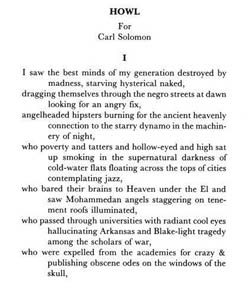 Just the other night I saw a fantastic performance of Allen Ginsberg’s Howl that took the poem — which I’d always found alluring but ultimately remote on the page — and, through the conjury of five actors, made it concrete, a perceived reality. I dug Ginsburg’s words. I downloaded them, as if across time. I was in cyberspace, but with sweat and pheremones. The Beats, too, sought sublimity — transport to a virtual world. So, too, did the cyberpunks in the net’s early days. So, too, did early Christian monastics, an analogy that Pang draws:
Just the other night I saw a fantastic performance of Allen Ginsberg’s Howl that took the poem — which I’d always found alluring but ultimately remote on the page — and, through the conjury of five actors, made it concrete, a perceived reality. I dug Ginsburg’s words. I downloaded them, as if across time. I was in cyberspace, but with sweat and pheremones. The Beats, too, sought sublimity — transport to a virtual world. So, too, did the cyberpunks in the net’s early days. So, too, did early Christian monastics, an analogy that Pang draws:
…cyberspace expresses a desire to transcend the world; Web 2.0 is about engaging with it. The early inhabitants of cyberspace were like the early Church monastics, who sought to serve God by going into the desert and escaping the temptations and distractions of the world and the flesh. The vision of Web 2.0, in contrast, is more Franciscan: one of engagement with and improvement of the world, not escape from it.
The end of cyberspace may mean the fusion of real and virtual worlds, another layer of a massively mediated existence. And this raises many questions about what is real and how, or if, that matters. But the end of cyberspace, despite all the sweeping gospel of Web 2.0, continuous computing, urban computing etc., also signals the beginning of something terribly mundane. Networks of fiber and digits are still human networks, prone to corruption and virtue alike. A virtual environment is still a natural environment. The extraordinary, in time, becomes ordinary. And undoubtedly we will still search for lines to cross.
end of cyberspace
The End of Cyberspace is a brand-new blog by Alex Soojung-Kim Pang, former academic editor and print-to-digital overseer at Encyclopedia Britannica, and currently a research director at the Institute for the Future (no relation). Pang has been toying with this idea of the end of cyberspace for several years now, but just last week he set up this blog as “a public research notebook” where he can begin working through things more systematically. To what precise end, I’m not certain.
The end of cyberspace refers to the the blurring, or outright erasure, of the line between the virtual and the actual world. With the proliferation of mobile devices that are always online, along with increasingly sophisticated social software and “Web 2.0” applications, we are moving steadily away from a conception of the virtual — of cyberspace — as a place one accesses exclusively through a computer console. Pang explains:
Our experience of interacting with digital information is changing. We’re moving to a world in which we (or objects acting on our behalf) are online all the time, everywhere.
Designers and computer scientists are also trying hard to create a new generation of devices and interfaces that don’t monopolize our attention, but ride on the edges of our awareness. We’ll no longer have to choose between cyberspace and the world; we’ll constantly access the first while being fully part of the second.
Because of this, the idea of cyberspace as separate from the real world will collapse.
If the future of the book, defined broadly, is about the book in the context of the network, then certainly we must examine how the network exists in relation to the world, and on what terms we engage with it. I’m not sure cyberspace has ever really been a home for the book, but it has, in a very short time, totally altered the way we read. Now, gradually, we return to the world. But changed. This could get interesting.
the “talk to me” crew talks with the institute
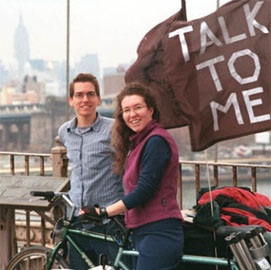 Liz Barry and Bill Wetzel, the people behind Talk to Me, stopped by the institute offices for lunch today. It is easy to describe what they do, they carry a sign that says “talk to me” and travel the country talking to strangers. However, it is a bit harder to categorize what they do. While not quite a social experiment, they playfully recounted how various places contextualize what they do. In the Upper West Side of New York they are quasi-therapists, while further south in the East Village they are performance artists. Recently, they biked across the country and back, all the while talking to strangers.
Liz Barry and Bill Wetzel, the people behind Talk to Me, stopped by the institute offices for lunch today. It is easy to describe what they do, they carry a sign that says “talk to me” and travel the country talking to strangers. However, it is a bit harder to categorize what they do. While not quite a social experiment, they playfully recounted how various places contextualize what they do. In the Upper West Side of New York they are quasi-therapists, while further south in the East Village they are performance artists. Recently, they biked across the country and back, all the while talking to strangers.
The thing that struck me is how they spend their time talking to people just to do it, without some agenda. They are not fund raisers for a non-profit or religious organization, nor do they take money from people after they talk to them (although they accept paypal and mailed donations.) There is no big book deal, reality tv show, or documentary film project looming in the background. They just wanted to start talking to different people and over three years later, the conversation is still ongoing. When I was in graduate school, by my second year, I started feeling that I only did things, so that I could document them for future projects. I get no such impression from Bill and Liz.
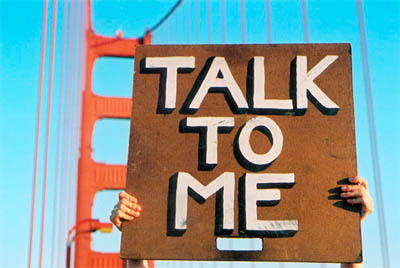
With blogs, photo sharing services, social networking sites, and affordable digital photography and video cameras, anyone can become a content creator and publisher. Documentation begins to drive all activity. Often, I have seen people walking in Times Square with a digital video camera in hand. Oblivious to their surroundings, they were completely preoccupied with documenting everything. Will they ever watch the endless hours of footage they are recording? Obviously, the camera filters their experience. When Liz and Bill set up shop in Time Square, they mainly want to engage in conversation. Their experiences would be very different if they held cameras, because the interaction shifts from a conversation to an interview.
I am glad that they collected some photos along their journey and recorded their thoughts in journals. I am also glad that they did not let that documentation process interfere with their project, whatever “it” is.
i am the person of the year
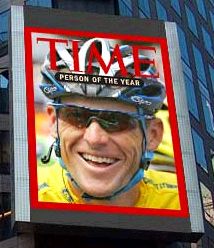
Time magazine is allowing anyone to submit photos of people they want to be “Person of the Year” to be projected on a billboard in Times Square. However, the website states that what they really want is to have people submit photos of themselves. All the photos that are selected to be projected will be photographed by webcam and their owners will be contacted. The images can be viewed, printed and sent to friends.
If the chance of seeing your image on a giant billboard in Times Square in real time is small, what is the difference between having Time photoshop your face onto its cover and doing it yourself? Is it the idea of projecting your image onto a billboard (which can be simulated as well)?
Is this Time magazine diminishing their role as information filter or it is an established news outlet recognizing the idea that anyone can be a publisher?
are we real or are we memorex
i saw four live performances and a dozen gallery shows over the past few days; one theme kept coming up– what is the relationship of simulated reality to reality. here are some highlights and weekend musings.
thursday night: “Supervision,” a play by the Builders Association and DBox about 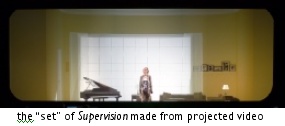 the infosphere which seems to know more about us than we do — among other things “it” never forgets and rarely plays mash-up with our memories the way human brains are wont to do. the play didn’t shed much light on what we could or should do about the encroaching infosphere but there was one amazing moment when video started shooting from left to right across the blank wall behind the actors. within moments a complete set was “constructed” out of video projections — so seamlessy joined at the edges and so perfectly shot for the purpse that you quickly forgot you were looking at video.
the infosphere which seems to know more about us than we do — among other things “it” never forgets and rarely plays mash-up with our memories the way human brains are wont to do. the play didn’t shed much light on what we could or should do about the encroaching infosphere but there was one amazing moment when video started shooting from left to right across the blank wall behind the actors. within moments a complete set was “constructed” out of video projections — so seamlessy joined at the edges and so perfectly shot for the purpse that you quickly forgot you were looking at video.
friday night: Nu Voices six guys making amazing house music, including digitized-sounding vocals, entirely with their voices. one of the group, Masai Electro, eerily imitated the sounds laurie anderson makes with her vocoder or that DJs make when they process vocals to sound robotic. the crowd loved it which made me wonder why we are so excited about hearing a human pretend to be a machine? i asked masai electro why he thinks the audience likes what he does so much. he had never been asked the question before and evidently hadn’t thought about it, but then spontaneously answered “because that’s where we’re going” meaning that humans are becoming machines or at least are becoming “at one” with them.
saturday afternoon: Clifford Ross’ very large landscapes (13′ x 6′) made with a super high resolution surveillance camera. a modern attempt at hudson river school lush landscapes. because of the their size and detail, you feel as if you are looking out a window at reality; makes you long for the “natural world” most of us rarely encounter.

left with a bunch of questions
does it make a difference if our experience is “real” or “simulated.” does that way of looking at things even make sense anymore. when we manage to add the smell of fresh air, the sound of the wind, the rustle of the grass, the bird in flight and the ability to walk around in life-size 3-D spaces to the clifford ross photos, what will be the meaningful difference between walking in the countryside and opening the latest “you are there” coffee table book of the future. in a world with limited resources i can see the value of subsituting vicarious travel for the real thing (after all if all 7 billion of us traipsed out to the galapagos during our lifetimes, the “original” would be overrun and despoiled, turning it into its opposite). but what does it mean if almost all of our experience is technologically simulated and/or mediated?
Pedro Meyer in his comment about digitally altered photos says that all images are subjective which makes altered/not-altered a moot distinction. up until now the boundary between mediated objects and “reality” was pretty obvious, but i wonder if that changes when the scale is life-like and 3D. the Ross photos and the DBox video projections foreshadow life-size media which involves all the senses. the book of the future may not be something we hold in our hands, it might be something a 3-dimensional space we can inhabit. does it make any difference if i’m interacting only with simulacra?
war on text?

Last week, there was a heated discussion on the 1600-member Yahoo Groups videoblogging list about the idea of a videobloggers launching a “war on text” — not necessarily calling for book burning, but at least promoting the use of threaded video conversations as a way of replacing text-based communication online. It began with a post to the list by Steve Watkins and led to responses such as this enthusiastic embrace of the end of using text to communicate ideas:
Audio and video are a more natural medium than text for most humans. The only reason why net content is mainly text is that it’s easier for programs to work with — audio and video are opaque as far as programs are concerned. On top of that, it’s a lot easier to treat text as hypertext, and hypertext has a viral quality.
As a text-based attack on the printed work, the “war on text” debate had a Phaedrus aura about it, especially since the vloggers seemed to be gravitating towards the idea of secondary orality originally proposed by Walter Ong in Orality and Literacy — a form of communication which is involved at least the representation of an oral exchange, but which also draws on a world defined by textual literacy. The vlogger’s debt to the written word was more explicitly acknowledged some posts, such as one by Steve Garfield that declared his work to be a “marriage of text and video.”
Over several days, the discussion veered to cover topics such as film editing, the over-mediation of existence, and the transition from analog to digital. The sophistication and passion of the discussion gave a sense of the way at least some in the video blogging community are thinking, both about the relationship between their work and text-based blogging and about the larger relationship between the written word and other forms of digitally mediated communication.
Perhaps the most radical suggestion in the entire exchange was the prediction that video itself would soon seem to be an outmoded form of communication:
in my opinion, before video will replace text, something will replace video…new technologies have already been developed that are more likely to play a large role in communications over this century… how about the one that can directly interface to the brain (new scientist reports on electroencephalography with quadriplegics able to make a wheelchair move forward, left or right)… considering the full implications of devices like this, it’s not hard to see where the real revolutions will occur in communications.
This comment implies that debates such as the “war on text” are missing the point — other forms of mediation are on the horizon that will radically change our understanding of what “communication” entails, and make the distinction between orality and literacy seem relatively miniscule. It’s an apocalyptic idea (like the idea that the internet will explode), but perhaps one worth talking about.
the evils of photoshop?

In a larger essay which bemoans the rise of image culture, Christine Rosen goes after Photoshop and its users in The New Atlantis, a right-leaning journal concerned with the intersection of technology and cultural values. According to Rosen, the software “democratizes the ability to commit fraud,” corrupting its users by giving them easy access to the tools of reality manipulation. She writes:
Photoshop has introduced a new fecklessness into our relationship with the image. We tend to lose respect for things we can manipulate. And when we can so readily manipulate images–even images of presidents or loved ones–we contribute to the decline of respect for what the image represents…
Worrying about photographic fakery isn’t new, of course — as Rosen herself notes, Susan Sontag inveighed against manipulated images in her 1977 work On Photography, and Rosen takes her point that images have been manipulated prior to the age of digitization. Here, however, Rosen’s concern with digital manipulation focuses less on the ability of people to deceive others with altered photos than on the ability of Photoshop to propel its users towards a general irreverence towards the real. This is an interesting inversion of the point that Bob Stein makes in a recent post; namely, that we have less respect for digitally manipulated images than ones which are “real.”
Later in the essay, Rosen suggests that some Photoshop images can be seen as the equivalent of today’s carnival sideshow:
“Photoshop contests” such as those found on the website Fark.com offer people the opportunity to create wacky and fantastic images that are then judged by others in cyberspace. This is an impulse that predates software and whose most enthusiastic American purveyor was, perhaps, P. T. Barnum. In the nineteenth century, Barnum barkered an infamous “mermaid woman” that was actually the moldering head of a monkey stitched onto the body of a fish. Photoshop allows us to employ pixels rather than taxidermy to achieve such fantasies, but the motivation for creating them is the same–they are a form of wish fulfillment and, at times, a vehicle for reinforcing our existing prejudices.
Looking at the Photoshop image above (which I pulled from the first Fark photoshop contest I came across), I can see the root of Rosen’s indignation: there is something offensive about the photo’s casual attitude toward an iconic image. But having seen similarly offensive editorial cartoons that riff on iconic phototographs, I’m not persuaded that Photoshop is the issue. It is true that without Photoshop this image would not have been made; indeed, as Rosen suggests, there is a Photoshop subculture on Fark that promotes the creation of absurd and often offensive images. But can we really make the argument that those who create these images become, in the process, less respectful of the reality they represent? I tend to resist such technological determinism: I would argue, against Rosen, that people manipulate images because they are already irreverent towards them — or, alternately, because they are cynical about the ability of images to represent truth.
